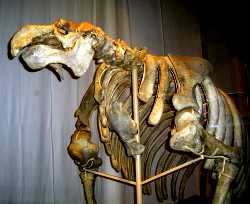Further Skeletons
1879, at the end of the Voyage of the Vega
*)finding the Northeast Passage, the Swedish discoverer Adolf Erik Nordenskiöld spent 5 days on Bering-Island. He was keen to collect skeletal parts of the seacow there, and offered the native creoles
*)Russian-Alëut half-cast generous premiums for each delivered find. As a result Nordenskiöld brought 21 large crates and barrels full of skeletal materials back to Sweden. These are today in the museums of Gothenburg, Lund, Stockholm and Uppsala.
A translation from the St. Petersburg journal Priroda (Nature) No. 8, 2002:
"Beginning of June 1882 the steamer Moskva sank in the Red Sea. On board were three complete skeletons, which Grebnitzky had sent for the Academy of Sciences in St. Petersburg."
[The Russian steamer Moskva of the 'Voluntary Fleet' sank on the 6th June 1882, close to Cape Guardafui, in the Gulf of Aden, en route from Hankow to St. Petersburg]
The Polish physician and scientist Benedykt Dybowski visited Bering-Island several times between 1879 and 1883
*)he met Nordenskiöld and Stejneger there and excavated numerous skeletons and skulls, which today are displayed in the museums of Kharkiv, Kiev, Cracow, Lviv, Odessa and Vienna. A skull in Warsaw was destroyed during the war.
As already explained, the existing skeletons came almost exclusively from the butchering sites of the years 1742-1768, and are usually incomplete and composed of several individuals. As can be expected, many of the smaller bones have been overlooked:
Only a few skulls still have their periotics.
1742 Steller had sent a pair of the horny
masticatory plates to St. Petersburg. 1832 J. F. Brandt found "between junk in the Petersburg Museum"
*)J. A. Wagner 1846 in Schreber's "Säugthiere" a single upper masticatory plate, most probably part of this consignment. It is the only existing specimen. Any horn substances remaining in the soil have decomposed like all cartilaginous components of the skeletons.

Probably nine sternums exist today (Dresden, Helsinki, Irkutsk, Kharkiv, Kiev(2), Ottawa, St. Petersburg, Stockholm and Washington). On the Helsinki specimen the cartilage segments joining the first 5 pairs of ribs to the sternum, and parts of the sternum itself, have been modelled .
Ulna and radius terminated
with
carpal and metacarpal. Steller mentioned these bones, however none is available.

old photo of Stockholm specimen with misinterpreted metacarpal |
A bone of the Stockholm specimen was for a while regarded as a metacarpal and fitted to the skeleton accordingly. But D. Domning later identified it as a transverse process of a sacral vertebra. During the assembly of the Helsinki and the Paris specimen, manatee-like replica of hand bones had been plastered erroneously (in Helsinki meanwhile removed).
Of the rudimentary pairs of
innominates (pelvic bones)
*)see above anatomy chapter, five halves are kept in museums:
| Town |
Museum |
|
| Berkeley |
Museum of Paleontology, University of California |
right, 59 cm |
| Braunschweig |
Naturkundemuseum |
right pelvis, 41 cm |
| Chabarowsk |
Regional Lore Museum |
right pelvis, 53 cm |
| Lyon |
Muséum National d'Histoire Naturelle |
right pelvis with broken proximal extremity |
| Wien |
Naturhistorisches Museum |
left pelvis, 45 cm,
ischial part probably broken off*)Domning 1978, S. 98. |
Three institutes claim to own a
skin fragment:
- St. Petersburg: 55 x 40 x 5 cm, which Alexander Brandt found 1871 in the Academy stores. Domning: "This ... needs reexamination. Liitken (1873) suggested that the fragment studied by A. Brandt is actually from a balaenid whale, and this seems likely to be true of all the samples".
- Hamburg: 25 x 25 cm, 1500 g, described 1950 by Dr. E. Mohr and 1956 by K. v. Haffner. This specimen has meanwhile been identified as humpback skin.
- Bremen: Das Überseemuseum Bremen besitzt zwei Hautstücke, die wie folgt beschrieben werden:
- ausgestellt: 85x52 cm, Gewicht 2800 g., stark zerklüftet, borkig, mit Parasiten (Cyamus und Tubicinella) besetzt.
- im Magazin: in 3 Teile zerschnitten, ursprünglich ca 84. x ca. 46 cm, 3,4 cm dick, 5500 g. früher vermutlich „gründlich“ gereinigt, möglicherweise aus Hals- oder Achselregion.
Die Herkunft der Stücke ist ungeklärt, sie wurden (1966?) ungekennzeichnet im Magazin entdeckt. Ein DNA-Sequenzanalyse wurde bisher nicht durchgeführt.
You find a detailed listing of all museum specimens in my
Database: Steller's Seacow in Museums.
(opens new window)

